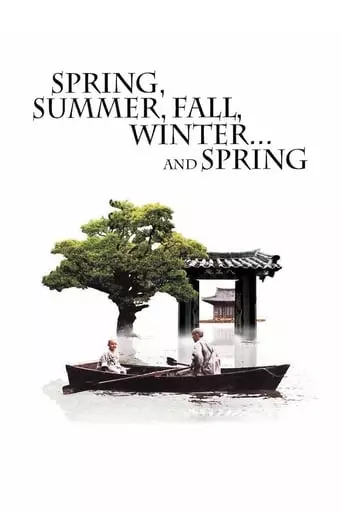
Spring, Summer, Fall, Winter and Spring (2003) Watch Online Free
An isolated lake, where an old monk lives in a small floating temple. The monk has a young boy living with him, learning to become a monk. We watch as seasons and years pass by.
Spring, Summer, Fall, Winter… and Spring is a visually stunning and meditative film by Korean director Kim Ki-duk, unfolding in a secluded Buddhist monastery floating on a serene lake. The film follows the life of a monk and his young apprentice through the passage of seasons, each representing different stages in life. The monk and apprentice live in peaceful solitude, practicing meditation and mindfulness. The boy, like many young people, becomes curious about the world beyond the monastery. As he grows, he faces the temptations and pitfalls of youth, including his first experience of lust and love, which leads him to make mistakes.
As the seasons change, so too do the characters. The boy becomes a man and learns hard lessons about life, suffering, and redemption. Over the years, he experiences deep emotional struggles, including loss, guilt, and violence, all of which lead him to return to the monastery for guidance. Ultimately, the cyclical nature of life, the teachings of Buddhism, and the repetition of mistakes across generations are central themes.
Analysis and Themes
The film is a powerful meditation on the themes of time, impermanence, and self-realization. Through its Buddhist framework, it explores samsara—the cycle of birth, death, and rebirth—and how each season reflects different stages in a person’s life. The peaceful setting of the lake and the monastery is not just a backdrop but a symbol of spiritual reflection. The minimalist narrative style emphasizes these themes, allowing the audience to feel the passage of time and the inevitability of change.
The film’s primary philosophical underpinning is the Buddhist concept of attachment and desire. The boy’s lust and his actions based on desire lead him down a path of suffering and violence. His eventual return to the monastery reflects the journey towards redemption, where forgiveness and self-awareness offer a chance for spiritual rebirth.
One of the most striking aspects of Spring, Summer, Fall, Winter… and Spring is the lack of dialogue and conventional plot. The film encourages viewers to reflect on their own lives, inviting them into a more introspective experience. It also explores the cyclical nature of existence—how the past repeats itself, and how the younger generation often walks the same path as the older one.
Impact of the Movie
The impact of this film is profound and lasting, as it encourages viewers to think about the deeper meaning of life, the inevitability of change, and the personal journey toward enlightenment. The quiet nature of the film allows it to be an immersive experience, where the audience becomes attuned to the passage of time and the rhythms of nature. By immersing viewers in the serene atmosphere of the monastery, the film provides a space for reflection on one’s own emotional and spiritual struggles. It is a cinematic journey that transcends cultural boundaries, offering universal themes of growth, loss, and renewal.
After watching Spring, Summer, Fall, Winter… and Spring, you are likely to feel a sense of calm and introspection. The film’s meditative nature, combined with its powerful portrayal of the cycle of life, invites a contemplative mood. You might reflect on your own experiences with love, loss, and personal growth, and perhaps consider how your own life is shaped by the desires and attachments you hold.
The film has a way of staying with you, as it subtly suggests that while we cannot avoid suffering or mistakes, there is always the possibility of redemption and growth. You may feel a sense of closure or peace, having witnessed a journey toward self-understanding that mirrors the natural rhythms of life. Ultimately, Spring, Summer, Fall, Winter… and Spring is a cinematic experience that lingers in the heart, encouraging personal reflection on one’s path toward wisdom and enlightenment
